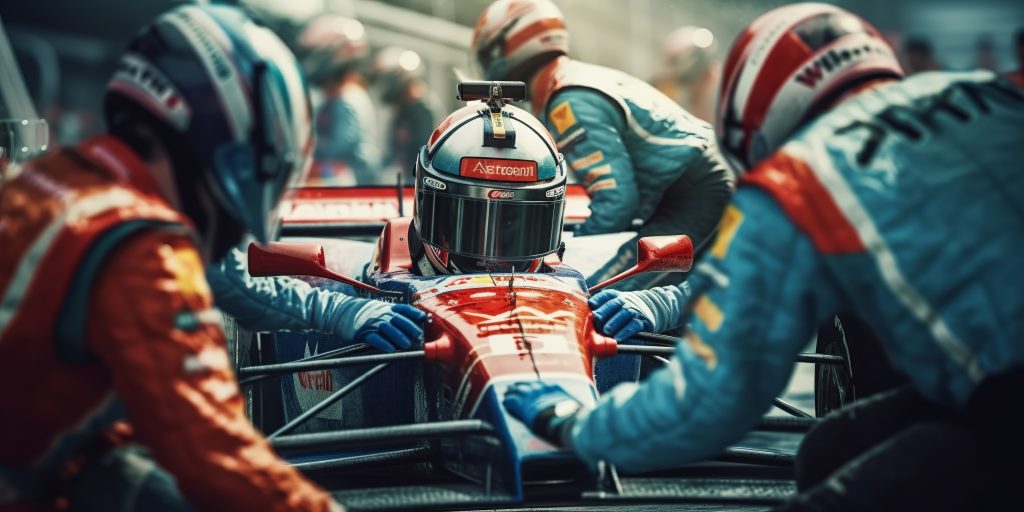As you stand at the edge of the racetrack, watching the sleek and powerful race cars zoom past you, you can’t help but wonder what it is that makes them so incredibly fast and agile. It’s not just their engines or tires, but there’s something more, something that sets them apart from ordinary vehicles. You’re about to discover the key elements that make a race car truly exceptional. From the intricate science behind shock absorbers to the art of aerodynamics and the mental fortitude of the driver, each aspect plays a vital role in the performance and success of a race car. Get ready to uncover the secrets that lie beneath the surface and unlock a world of speed and precision.
Importance of Shocks in Racing
The proper functioning and adjustment of shocks are of utmost importance in racing, as they play a critical role in optimizing handling, tire grip, and overall performance of the race car. Shocks, also known as shock absorbers, come in different types and are responsible for controlling the speed at which the wheels move up and down. They work by absorbing and dampening shock impulses, reducing oscillations, and dissipating energy from the springs. This allows the tires to maintain traction and absorb bumps and obstacles, improving tire grip and ensuring a smooth and stable ride.
The damping force, which is the resistance oil experiences while moving through the piston and base valve, is a crucial aspect of shock performance. It affects the suspension stiffness and how the car responds to different road conditions. Adjusting the compression and rebound damper settings of the shocks can optimize race performance by finding the right balance between comfort and speed. Highly adjustable shocks allow for precise tuning of high-speed and low-speed damping, catering to different driver preferences and track conditions.
When choosing shocks for your race car setup, it is important to consider factors such as ease of installation, continued support, and the reputation of the manufacturer. Penske Racing Shocks, for example, is a custom shock manufacturer known for their quality products and comprehensive support. By understanding the importance of shocks and making informed decisions, you can maximize the performance of your race car on the track.
Understanding Shock Absorbers
To understand shock absorbers, it is important to grasp their role in controlling the movement of the wheels and optimizing the performance of a race car. Shock absorbers are hydraulic devices that play a crucial role in the suspension system of a race car. Here are some key points to consider:
- Shock tuning techniques: Properly tuning the shocks can greatly impact the handling and performance of a race car. Adjusting compression and rebound damper settings can optimize the car’s performance on different types of tracks and conditions.
- Types of shock absorbers: There are various types of shock absorbers available, including coilover shocks, gas shocks, and adjustable shocks. Each type has its own advantages and can be tailored to suit specific racing needs.
- Impact of shock settings on tire grip: The settings of the shock absorbers directly affect the tire grip. By finding the right balance between stiffness and softness, drivers can ensure optimal traction and control during cornering and braking.
- Effect of shock absorbers on cornering ability: Well-tuned shock absorbers can improve a race car’s cornering ability by controlling body roll and maintaining stability. This allows the car to maintain its line through corners and achieve faster lap times.
- Shock absorber maintenance tips: Regular maintenance is essential to ensure the longevity and performance of shock absorbers. This includes checking for leaks, cleaning the shocks, and replacing worn-out components. It is also important to follow the manufacturer’s recommended maintenance schedule.
Understanding shock absorbers and their role in a race car’s performance is crucial for achieving optimal results on the track. By implementing proper shock tuning techniques, choosing the right type of shock absorbers, and maintaining them regularly, drivers can enhance their racing experience and improve their chances of success.
How Shocks Work in a Race Car
Moving on to the topic of shock absorbers and their role in a race car’s performance, it is crucial to understand how these hydraulic devices work to optimize handling, stability, and tire grip. Shock absorbers play a vital role in controlling the movement of the wheels, ensuring that the tires maintain contact with the road surface during cornering and over bumps.
Shock absorbers employ various shock absorption techniques to achieve this. They consist of several components, including a piston, cylinder, and valves. When the wheels encounter a bump or an irregularity on the track, the shock absorbers compress, allowing the piston to move through the cylinder. This compression process absorbs the energy generated by the impact, preventing excessive wheel movement and maintaining tire grip.
Shock tuning strategies involve adjusting the shock settings to optimize performance. By altering the compression and rebound damping settings, drivers can fine-tune the behavior of the suspension system. Stiffer shocks can slow down the spring movement, providing more stability during cornering, while softer shocks allow for faster response and increased grip on uneven surfaces.
The impact of shock settings on a race car’s performance cannot be underestimated. Properly tuned shocks can enhance cornering abilities, improve traction, and provide a more predictable and responsive handling experience. They allow the car to maintain optimal tire contact with the road, maximizing grip and minimizing tire wear.
Adjusting Shocks for Optimal Performance
When adjusting shocks for optimal performance in a race car, it is crucial to carefully fine-tune the compression and rebound damping settings. Shock tuning plays a vital role in suspension setup and handling optimization, allowing drivers to extract the maximum performance from their race cars. Here are four key considerations when making damping adjustments:
- Compression Damping: Adjusting the compression damping controls the shock’s resistance to compression forces. Increasing compression damping can improve stability during cornering and braking, while decreasing it can enhance grip and responsiveness.
- Rebound Damping: Rebound damping regulates the shock’s ability to rebound after compression. Increasing rebound damping can prevent excessive body roll and maintain tire contact with the road, while reducing it can improve traction and absorb bumps more effectively.
- Suspension Stiffness: Fine-tuning the shock settings is essential for achieving the desired suspension stiffness. A stiffer setup can provide better control and responsiveness, while a softer setup can enhance comfort and grip.
- Dynamic Balance: The adjustments made to the shocks should also consider the overall dynamic balance of the race car. Balancing the front and rear damping settings ensures optimal weight transfer, cornering stability, and traction.
Choosing the Right Shocks for Your Race Car
After fine-tuning the compression and rebound damping settings for optimal performance in your race car, the next crucial step is selecting the right shocks for your setup. Shocks play a vital role in your car’s handling, tire grip, and aerodynamic impact, all of which directly affect your driver performance on the track. When choosing shocks, it’s important to consider the different shock types available and the various shock manufacturers in the market.
There are different types of shocks to choose from, such as coilovers, adjustable shocks, and gas shocks. Coilovers offer the advantage of adjustable ride height and damping, allowing you to fine-tune your car’s performance. Adjustable shocks provide the flexibility to adjust compression and rebound damping settings, allowing you to optimize your car’s handling characteristics. Gas shocks, on the other hand, use pressurized gas to provide better control and stability.
When selecting shocks, it’s crucial to consider the reputation and quality of the shock manufacturer. Look for manufacturers known for their expertise and track record in producing high-performance shocks. Research and read reviews to gain insights into the performance and durability of different shock brands.
Remember that shock adjustments can have a significant impact on your car’s handling and overall performance. Experiment with different compression and rebound damping settings to find the optimal balance between comfort and speed. Fine-tuning your shocks can help maximize grip, minimize body roll, and improve stability, allowing you to push your car to its limits on the race track.
Frontal Area and Aerodynamic Drag
Frontal area plays a crucial role in determining the aerodynamic drag experienced by a race car. The size of the frontal area directly impacts the amount of drag encountered while racing. To reduce drag and improve aerodynamic efficiency, race car designers employ various drag reduction techniques. These techniques focus on minimizing the frontal area of the car to decrease the resistance it faces when moving through the air. Here are four key aspects related to frontal area impact in race car design:
- Streamlined Body: Modern race cars are designed with sleek and compact bodies to reduce frontal area. The smooth contours and tapering shape help the car cut through the air more efficiently, minimizing drag.
- Tucked-in Wheels: Another technique to reduce frontal area is to tuck the wheels inside the body. This reduces the exposed surface area and improves aerodynamic performance.
- Low-profile Design: Race cars are often designed with a low-profile stance to decrease the frontal area. This helps to minimize the drag force acting on the car and improve its overall aerodynamic efficiency.
- Windshield Shape: The shape and angle of the windshield also play a role in reducing frontal area and drag. A more sloped and streamlined windshield design helps to direct the airflow over the car more smoothly, reducing drag.
Front Splitter and Downforce Generation
To further optimize aerodynamic performance and enhance downforce generation, race car designers incorporate a crucial component known as the front splitter. The front splitter, also known as a front spoiler, is a flat panel that extends from the front bumper of the race car. Its purpose is to manipulate the airflow underneath the car and generate downforce.
The benefits of a front splitter are significant. By creating a pressure difference between the top surface and the low-pressure air underneath, the front splitter generates downforce. This downforce helps improve the grip and stability of the front tires during high-speed cornering, allowing the car to maintain better control and maneuverability.
Front splitter design is crucial to maximize its effectiveness. It should be designed to smoothly transition the airflow from the front of the car to the underside, minimizing turbulence and reducing drag. The materials used for front splitters are typically lightweight and durable, such as carbon fiber or fiberglass composites, to ensure minimal weight addition and high strength.
Proper installation and maintenance of the front splitter are essential. It should be securely mounted to the front bumper to withstand high-speed forces and vibrations. Regular inspection and maintenance are necessary to ensure any damage or wear is addressed promptly, as a damaged front splitter can negatively impact the car’s aerodynamic performance.
Factors Affecting Driver Performance in Racing
Driver performance in racing is influenced by various factors that can impact their cognitive function, physical well-being, and overall ability to perform at their best on the track. To ensure optimal performance, drivers must pay attention to hydration and its effects on cognitive function. Mild dehydration can impair cognitive function and reaction time, so maintaining proper hydration levels is crucial. In hot racing environments, regulating body temperature is essential to prevent heat exhaustion and heat stroke. Cooling down the body between races can be achieved by using ice packs or cold towels. Muscle cramping and fatigue can also hinder performance, so drivers should aim to prevent these symptoms by consuming electrolyte-rich fluids like sports drinks and foods rich in potassium and magnesium. Dizziness and lightheadedness can negatively affect focus and control, so proper hydration is important to prevent these symptoms. Lastly, maintaining healthy kidney function is crucial during long races, as excessive caffeine or alcohol consumption can have a diuretic effect. Drivers must prioritize hydration to prevent kidney damage and related conditions, especially since bathroom breaks during races may be limited.


